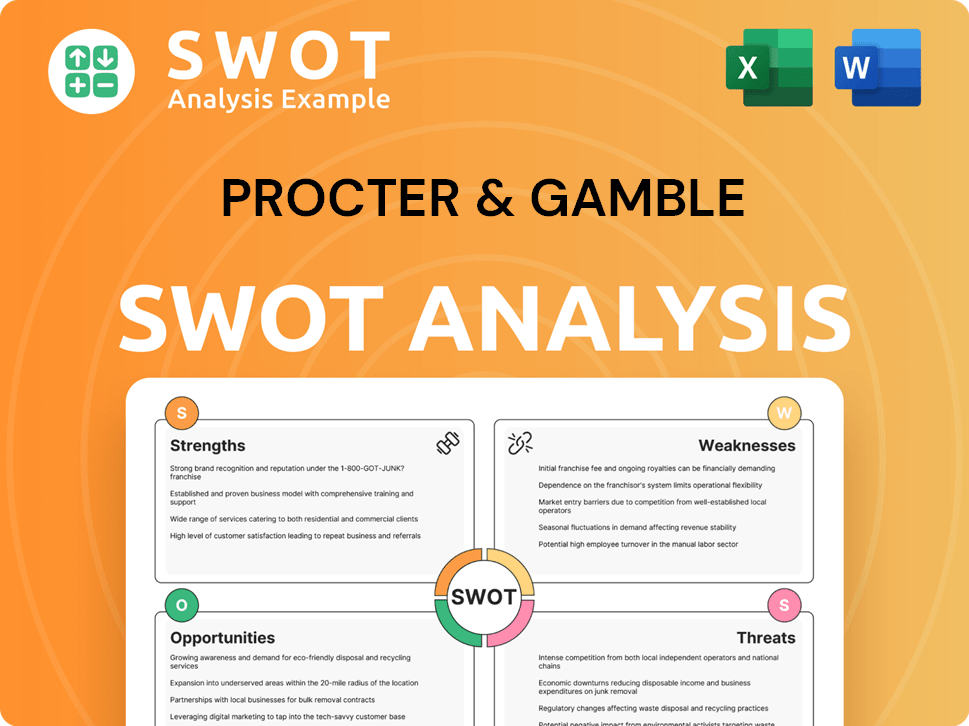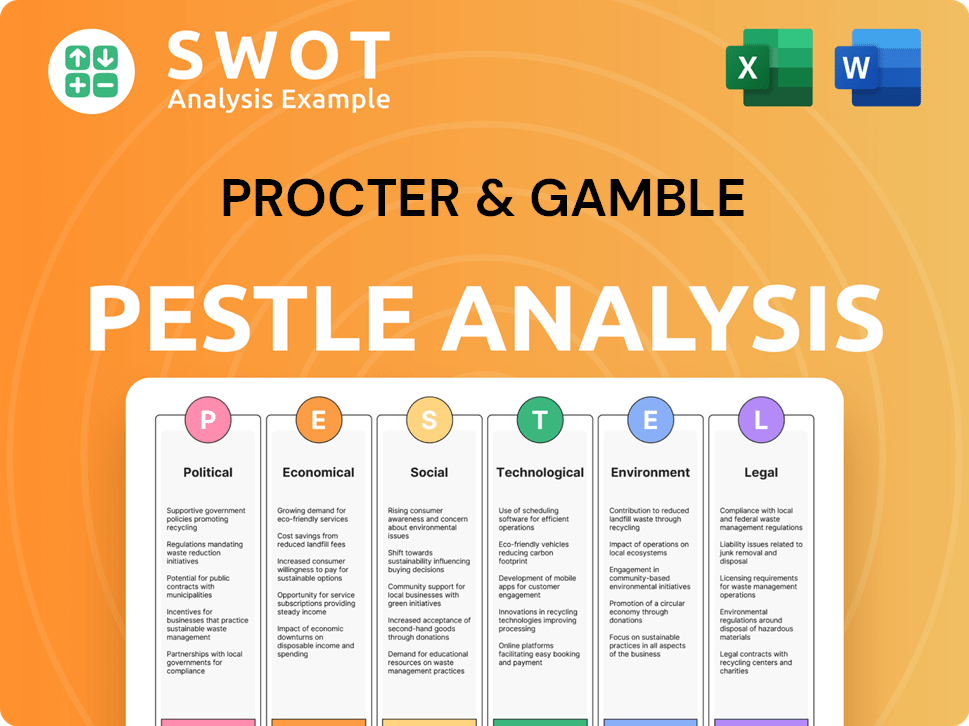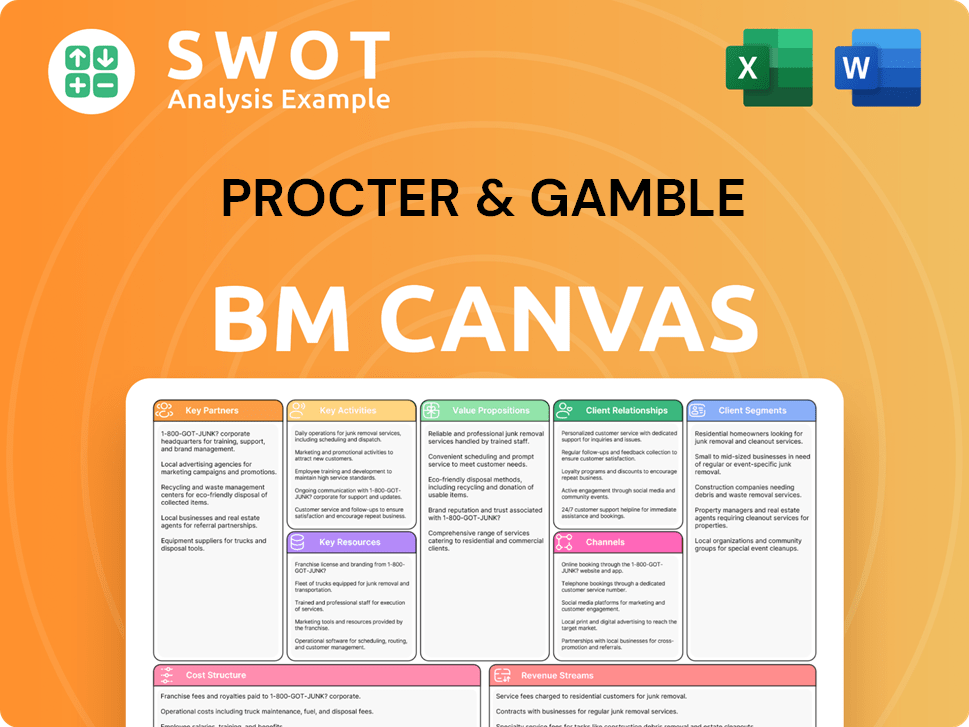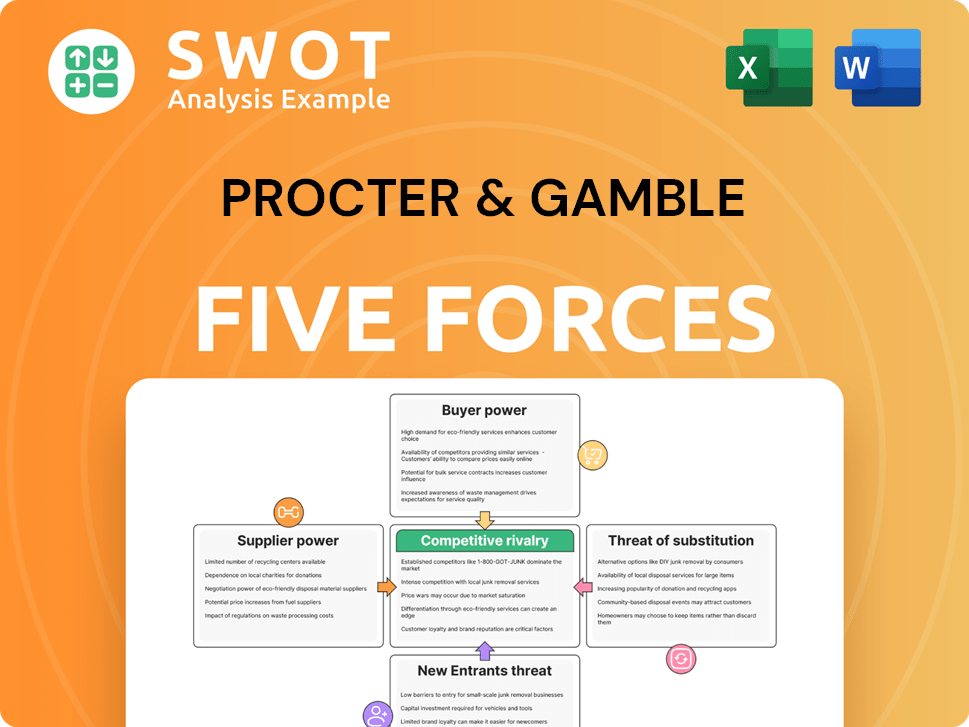Procter & Gamble Bundle
Can Procter & Gamble Maintain Its Dominance in Today's Market?
From its humble beginnings in 1837, Procter & Gamble (P&G) has evolved into a global powerhouse, but how does it fare in the cutthroat world of consumer goods? This analysis dives deep into the Procter & Gamble SWOT Analysis, revealing the intricate web of its competitive landscape and the strategies it employs to stay ahead. We'll dissect P&G's market position and explore its key rivals.

Understanding the Procter & Gamble competitive landscape is crucial for anyone looking to understand the broader consumer goods market. This exploration will examine P&G's competitive advantage, detailing its key competitors and how it navigates the challenges of the P&G industry. We will also conduct a thorough Procter & Gamble market analysis to identify the company's strengths and weaknesses.
Where Does Procter & Gamble’ Stand in the Current Market?
Procter & Gamble (P&G) maintains a strong market position in the global consumer goods industry. The company leverages a vast portfolio of well-known brands and a broad global reach. P&G's presence is significant across numerous segments, consistently holding leading positions.
In fiscal year 2023, P&G reported net sales of $82.0 billion, demonstrating its substantial scale within the industry. Key product lines such as Tide, Pampers, Gillette, Crest, and Charmin often lead their respective markets or hold considerable market shares. For example, Pampers has a significant share in the global disposable diapers market. P&G's financial health is robust, supported by a strong balance sheet and consistent cash flow generation.
Geographically, P&G has a strong presence in developed and developing markets, with a significant portion of its sales coming from North America, Europe, and Asia. P&G has strategically shifted its positioning over time, divesting from non-core brands to focus on higher-growth, higher-margin categories. In the second quarter of fiscal year 2024, organic sales increased by 4%, reflecting continued growth despite economic challenges. To learn more about the company's origins, you can explore the Brief History of Procter & Gamble.
P&G often leads in many categories. For instance, Pampers holds a substantial share in the global disposable diapers market. The company's strong market position is a key factor in its competitive advantage within the consumer goods market.
P&G has a strong presence across developed and developing markets. A significant portion of its sales comes from North America, Europe, and Asia. P&G's global reach is a key component of its competitive strategy.
In fiscal year 2023, P&G reported net sales of $82.0 billion. The company's financial health is robust, supported by a strong balance sheet and consistent cash flow generation. Organic sales increased by 4% in the second quarter of fiscal year 2024.
P&G has shifted its focus to higher-growth, higher-margin categories. This strategic move allows the company to concentrate resources on its most profitable segments. This approach strengthens P&G's competitive positioning.
P&G's market position is characterized by strong brand recognition, global reach, and robust financial performance. The company consistently adapts its strategy to maintain its competitive edge in the consumer goods market. P&G's ability to innovate and meet consumer needs is crucial.
- Leading market shares in key product categories.
- Strong presence in both developed and emerging markets.
- Consistent financial performance and strategic focus on high-growth areas.
- Continuous innovation and adaptation to consumer preferences.
Procter & Gamble SWOT Analysis
- Complete SWOT Breakdown
- Fully Customizable
- Editable in Excel & Word
- Professional Formatting
- Investor-Ready Format

Who Are the Main Competitors Challenging Procter & Gamble?
The Marketing Strategy of Procter & Gamble faces intense competition across its diverse product categories and global markets. Understanding the Procter & Gamble competitive landscape is crucial for investors, analysts, and strategists. Key rivals employ various tactics, including pricing strategies, innovation, and marketing campaigns, to gain market share.
The P&G industry is highly competitive, with established players and emerging brands constantly vying for consumer attention. This dynamic environment necessitates a deep dive into P&G competitors and their strategies. The Procter & Gamble market analysis reveals a complex interplay of factors influencing the company's performance and future prospects.
Procter & Gamble's main rivals include multinational consumer goods giants. These competitors challenge P&G through aggressive pricing, continuous product innovation, and robust distribution networks. The competitive landscape also includes smaller, direct-to-consumer (DTC) brands and private label brands.
Unilever is a major competitor, directly challenging P&G in home care and personal care. Unilever's extensive brand portfolio and strong presence in emerging markets pose a significant threat. In 2023, Unilever reported underlying sales growth of 7.0%, indicating strong global performance.
Colgate-Palmolive is a key competitor in oral care and pet nutrition. The company's focus on these specific segments allows it to compete effectively. Colgate-Palmolive's net sales for 2023 reached approximately $19.9 billion.
Kimberly-Clark competes fiercely with P&G in baby care and feminine care. The Huggies vs. Pampers battle in the diaper market is a prime example of their rivalry. Kimberly-Clark's organic sales growth in 2023 was 4%.
Henkel challenges P&G in laundry and home care with brands like Persil. Henkel's strategic focus on innovation and sustainability has allowed it to gain market share. Henkel's sales in 2023 were around €21.5 billion.
Smaller, direct-to-consumer (DTC) brands are leveraging e-commerce and social media. These brands often target niche markets, posing a growing challenge to established players. The DTC market is expected to continue growing, with projections indicating significant expansion in the coming years.
Private label brands offered by major retailers provide consumers with lower-priced alternatives. These brands compete directly with P&G products, particularly in the household and personal care categories. The market share of private label brands continues to increase, putting pressure on P&G's pricing strategies.
Competitive advantage in the consumer goods market is determined by several factors. P&G and its rivals constantly innovate, launch marketing campaigns, and optimize distribution. The rise of e-commerce has significantly impacted the competitive analysis of P&G products.
- Pricing Strategies: Competitors use various pricing models, including discounts and promotions, to attract consumers.
- Product Innovation: New product formulations and features are constantly introduced to gain market share.
- Marketing and Branding: Extensive marketing campaigns and brand building are crucial for consumer loyalty.
- Distribution Networks: Robust distribution networks are essential for reaching consumers globally.
Procter & Gamble PESTLE Analysis
- Covers All 6 PESTLE Categories
- No Research Needed – Save Hours of Work
- Built by Experts, Trusted by Consultants
- Instant Download, Ready to Use
- 100% Editable, Fully Customizable

What Gives Procter & Gamble a Competitive Edge Over Its Rivals?
The competitive landscape for Procter & Gamble (P&G) is shaped by its strong competitive advantages, which have allowed it to maintain a leading position in the consumer goods market. P&G's success is built on a foundation of brand equity, economies of scale, global distribution, and a commitment to research and development. Understanding these strengths is crucial for any Procter & Gamble market analysis.
P&G's enduring success is underpinned by several core competitive advantages that differentiate it from its rivals. Foremost among these is its unparalleled brand equity. P&G boasts a portfolio of over 65 trusted brands, many of which are household names with deep consumer loyalty built over decades. This brand recognition and trust allow P&G to command premium pricing and maintain strong market positions even in highly competitive segments.
Another significant advantage lies in its vast economies of scale. As one of the largest advertisers globally, P&G benefits from substantial purchasing power in media buys and raw materials, leading to lower per-unit costs. Its extensive global distribution network, reaching over 180 countries, ensures its products are readily available to consumers worldwide, a logistical feat difficult for smaller competitors to replicate. This contributes significantly to P&G's competitive positioning in the consumer goods market.
P&G's portfolio includes over 65 brands, many of which are household names. These brands have built strong consumer loyalty over decades. This allows P&G to command premium pricing and maintain market share.
P&G benefits from significant economies of scale due to its size. As a major advertiser, it has substantial purchasing power. This results in lower per-unit costs, enhancing its competitive advantage.
P&G's products are available in over 180 countries worldwide. This extensive distribution network is a key logistical advantage. It ensures products are readily accessible to consumers globally.
P&G consistently invests heavily in R&D to drive product innovation. This leads to superior product performance and unique features. It results in patented technologies that set its offerings apart.
P&G's competitive advantages include strong brand equity, economies of scale, and a vast global distribution network. The company's consistent investment in research and development (R&D) is another critical differentiator. These factors contribute to P&G's ability to maintain its leading position in the P&G industry.
- Brand Strength: P&G's portfolio of trusted brands fosters consumer loyalty, allowing for premium pricing.
- Operational Efficiency: Economies of scale and a robust global distribution network reduce costs and enhance product availability.
- Innovation: Continuous investment in R&D drives product improvements and the creation of unique, patented technologies.
- Consumer Insights: Deep market research and data analytics enable P&G to effectively respond to evolving consumer preferences.
Procter & Gamble Business Model Canvas
- Complete 9-Block Business Model Canvas
- Effortlessly Communicate Your Business Strategy
- Investor-Ready BMC Format
- 100% Editable and Customizable
- Clear and Structured Layout

What Industry Trends Are Reshaping Procter & Gamble’s Competitive Landscape?
The consumer goods industry, where the [Company Name] operates, is experiencing significant shifts. These changes are driven by technological advancements, evolving consumer preferences, and regulatory pressures. The [Company Name]'s competitive landscape is being reshaped by these trends, necessitating strategic adaptations to maintain its market position and foster growth. A thorough Procter & Gamble competitive landscape analysis is crucial to understand these dynamics.
The company faces challenges such as supply chain disruptions and rising costs. However, opportunities abound in areas like sustainable innovation and emerging markets. Understanding the P&G industry and its competitive dynamics is essential. The company's future hinges on its ability to adapt to these evolving conditions, leveraging its strengths to capitalize on emerging opportunities and mitigate potential risks. The Procter & Gamble market analysis reveals these critical aspects.
E-commerce and digital marketing are transforming how consumers discover and purchase products. Regulatory changes regarding product safety and environmental impact are increasing. Consumer preferences are shifting towards sustainability, health, and personalized products. These trends shape the consumer goods market.
Managing supply chain disruptions and rising costs of raw materials and logistics are significant challenges. Competing with agile, digitally native brands that quickly respond to niche consumer demands is also critical. Maintaining relevance with younger generations who may not have the same brand loyalties poses another hurdle. The P&G competitors must navigate these challenges.
Developing sustainable product innovations, such as refillable packaging, can meet growing consumer demand. Expanding its presence in emerging markets offers substantial growth potential. Strategic partnerships with technology companies can enhance its digital footprint. Capitalizing on the demand for health and wellness products is another key area. To understand how to increase sales, read about the Growth Strategy of Procter & Gamble.
The company needs a more digitally integrated, sustainably focused enterprise. This includes targeted acquisitions and continued investment in R&D. Building direct relationships with consumers is also crucial. The goal is to remain resilient and competitive in the long term, leveraging its competitive advantage.
In fiscal year 2024, [Company Name] reported net sales of approximately $82 billion. The company has increased its digital marketing spending by over 15% annually in recent years. The global e-commerce sales for consumer packaged goods are projected to reach over $800 billion by 2025. Understanding these figures is essential for a detailed competitive landscape of P&G.
- [Company Name] has a significant presence in emerging markets, with sales in these regions accounting for over 30% of its total revenue in 2024.
- The company has launched several sustainable product initiatives, including recyclable packaging and plant-based ingredients, reflecting its commitment to environmental sustainability.
- [Company Name] continues to invest heavily in research and development, allocating approximately 2.5% of its net sales to innovation efforts.
- The company's brand portfolio includes several leading brands in the beauty, health, and household product categories.
Procter & Gamble Porter's Five Forces Analysis
- Covers All 5 Competitive Forces in Detail
- Structured for Consultants, Students, and Founders
- 100% Editable in Microsoft Word & Excel
- Instant Digital Download – Use Immediately
- Compatible with Mac & PC – Fully Unlocked

Related Blogs
- What are Mission Vision & Core Values of Procter & Gamble Company?
- What is Growth Strategy and Future Prospects of Procter & Gamble Company?
- How Does Procter & Gamble Company Work?
- What is Sales and Marketing Strategy of Procter & Gamble Company?
- What is Brief History of Procter & Gamble Company?
- Who Owns Procter & Gamble Company?
- What is Customer Demographics and Target Market of Procter & Gamble Company?
Disclaimer
All information, articles, and product details provided on this website are for general informational and educational purposes only. We do not claim any ownership over, nor do we intend to infringe upon, any trademarks, copyrights, logos, brand names, or other intellectual property mentioned or depicted on this site. Such intellectual property remains the property of its respective owners, and any references here are made solely for identification or informational purposes, without implying any affiliation, endorsement, or partnership.
We make no representations or warranties, express or implied, regarding the accuracy, completeness, or suitability of any content or products presented. Nothing on this website should be construed as legal, tax, investment, financial, medical, or other professional advice. In addition, no part of this site—including articles or product references—constitutes a solicitation, recommendation, endorsement, advertisement, or offer to buy or sell any securities, franchises, or other financial instruments, particularly in jurisdictions where such activity would be unlawful.
All content is of a general nature and may not address the specific circumstances of any individual or entity. It is not a substitute for professional advice or services. Any actions you take based on the information provided here are strictly at your own risk. You accept full responsibility for any decisions or outcomes arising from your use of this website and agree to release us from any liability in connection with your use of, or reliance upon, the content or products found herein.